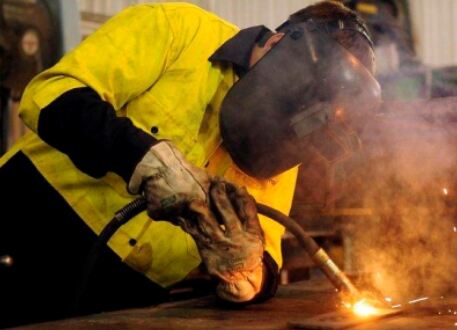
Welding Industry Personal Protective Equipment (PPE).
Welding workwear, often referred to as welding PPE (Personal Protective Equipment), is specialized clothing and gear designed to protect welders from the hazards associated with welding processes. Welding involves intense heat, sparks, UV radiation, and the potential for exposure to hazardous fumes and molten metal. Proper welding workwear is essential to ensure the safety and well-being of welders.
Here are common elements and features of welding workwear:
Welding Helmet: Welders wear a welding helmet with a protective visor that shields the eyes and face from intense light, sparks, and UV radiation produced during welding. Auto-darkening helmets automatically adjust the level of shading to protect the eyes when the welding arc is struck.
Welding Jacket: Welding jackets are made from flame-resistant materials to protect the upper body from sparks, slag, and heat. They often feature snap or hook-and-loop closures to seal out sparks.
Welding Gloves: Heavy-duty welding gloves made from heat-resistant materials such as leather or Kevlar protect the hands from burns and sparks. They also provide good dexterity for handling welding equipment.
Welding Sleeves: Welding sleeves are worn to protect the forearms from heat and sparks. They are typically made from flame-resistant materials and are available in various lengths.
Welding Apron: Some welders wear welding aprons for additional protection of the torso and upper legs. These aprons are designed to resist sparks and heat.
Welding Pants: Welding pants are made from flame-resistant materials and provide protection for the lower body. They are designed to resist welding-related hazards.
Welding Boots: Welding boots often have steel toes and heat-resistant soles to protect the feet from falling objects and hot materials.
Respiratory Protection: Depending on the welding process and materials being used, welders may need respiratory protection, such as a welding respirator, to filter out fumes and particulates.
Ear Protection: In situations with high noise levels, welders may wear ear protection, such as earplugs or earmuffs, to prevent hearing damage.
Welding Blanket or Curtain: Welding blankets and curtains can be used to shield nearby personnel and equipment from sparks and welding glare.
Head Covering: In some cases, welders wear a flame-resistant hood or head covering for additional protection of the head and neck.
Safety Glasses: Clear safety glasses may be worn under the welding helmet to protect the eyes from flying debris and particles.
Fire-Resistant Undergarments: Some welders wear fire-resistant undergarments to provide an additional layer of protection against burns.
Welding workwear is crucial to protect welders from burns, eye injuries, respiratory problems, and other welding-related hazards. Proper training in the use of welding PPE and adherence to safety procedures are also essential for welder safety. Regulations and industry standards often dictate the specific requirements for welding workwear and safety practices in various welding environments.